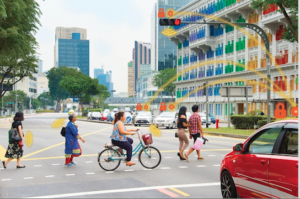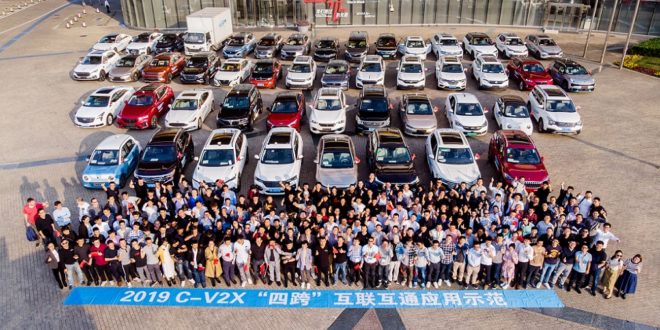
Cooperative mobility is set to be propelled by the mass adoption of
Long-Term Evolution (LTE Uu) vehicle connections and investment in roadside infrastructure connectivity. Shipments of vehicles that can communicate with LTE networks and road traffic agents will reach 62 million by the end of 2020 and over 97 million in 2024, according to a new market data report from global tech market advisory ABI RESEARCH.
Most of these shipments – 98% in 2020 – will be led by vehicles that
can share and receive messages about the vehicle status and the
existence of dangerous situations _via_ a traditional cellular network
connection (V2N).
V2N LTE communication is widely available and well-suited to
non-mission-critical applications. Here, use cases such as Green Light
Optimal Speed Advisory (GLOSA) and Intersection Collision Warning can add value to safety and traffic efficiency, reducing the number of road incidents.
“V2N offers the greatest opportunity in the next 4 years,
with 60.8 million shipments in 2020 rising to 76.6 million in 2024. This
represents an immediate monetization opportunity for players, yet not many OEMs offer V2N services to drivers,” says Maite Bezerra, Research Analyst at ABI Research.
The main obstacle to V2N implementation is the uncertainty surrounding the business model. Coupled with a scarcity of infrastructure, OEMs lack
experience in software development.
“The lack of infrastructure
equipment, such as traffic lights, able to communicate to the networks prevents the deployment of a range of use cases that would deliver immediate cooperative mobility benefits for connected car drivers,” Bezerra explains.
Although, a notable use case comes from Audi. Audi has implemented
network-based GLOSA at nearly 5,000 connected intersections in the U.S. since 2017, and the service is now available in Ingolstadt and
Düsseldorf, the latter committing to connect 75% of its traffic lights
by September 2020.
According to preliminary studies, the application can reduce fuel consumption by 15%.
Due to a lack of experience and skills in developing applications, OEMs offer expensive and unintuitive V2N services with a slow time-to-market.
Drivers will not subscribe to expensive services that do not add value, especially while apps such as Waze offer map updates and hazardous location notifications for free.
“Therefore, OEMs should collaborate with V2N service providers, such as HERE, Savari, Telenav, and TomTom, that offer an extensive range of relevant applications currently not
available to drivers,” Bezerra recommends.
Vehicles able to communicate to other vehicles and traffic agents
directly (V2X), will see minor deployment in 2020, but will then gather pace in 2021, reaching nearly 4 million shipments. V2X communication will allow nearby traffic agents to directly exchange messages about detected objects, so vehicles are made aware of objects outside their Line-of-Sight.
V2X enables a range of advanced safety applications – where vehicles communicate with one another for example – the NHTSA estimates that traffic accidents can be reduced by 13%. However, predominantly as a short-range technology, V2X requires high market adoption to reach full potential, which will take several years.
“Therefore, it is imperative that OEMs collaborate with municipal,
city or transport authorities to advance the build-out of roadside
communicating infrastructure. This will allow those vehicles equipped
with V2X to immediately see a benefit from the technology. These actors are more likely to engage in considerable infrastructure investments if OEMs commit to deploy V2X at low or no cost in the early years,” says Bezerra.
Vehicle communication using 5G will allow the introduction of autonomous vehicles (level 3 and 4) and services including cooperative perception and sensor data sharing. However, these use cases will only be feasible in the long term, requiring considerable infrastructure development.
Vehicles able to communicate to cellular networks and directly to other devices _via_ 5G will not emerge as a force until 2027, when shipments will hit 16.3 million.
“Vehicles are increasingly connected and will soon interact with each other and the road infrastructure, allowing road users and traffic managers to share information and coordinate their actions in a cooperative manner. This will result in improved road safety, traffic efficiency, faster driver decision-making processes, and improved safety of automated cars that can be integrated with the overall transport system. Therefore, cooperation, connectivity, and automation are complementary technologies that reinforce each other,” Bezerra concludes.
These findings are from ABI Research’s Cooperative Mobility: Phases, Use Cases, And Forecasts application analysis report. This report is part of the company’s Smart Mobility & Automotive research service, which includes research, data, and ABI Insights. Based on extensive primary interviews, Application Analysis reports present in-depth analysis on key market trends and factors for a specific technology.
 ..:: AUTO REPORT AFRICA ::..
..:: AUTO REPORT AFRICA ::..




